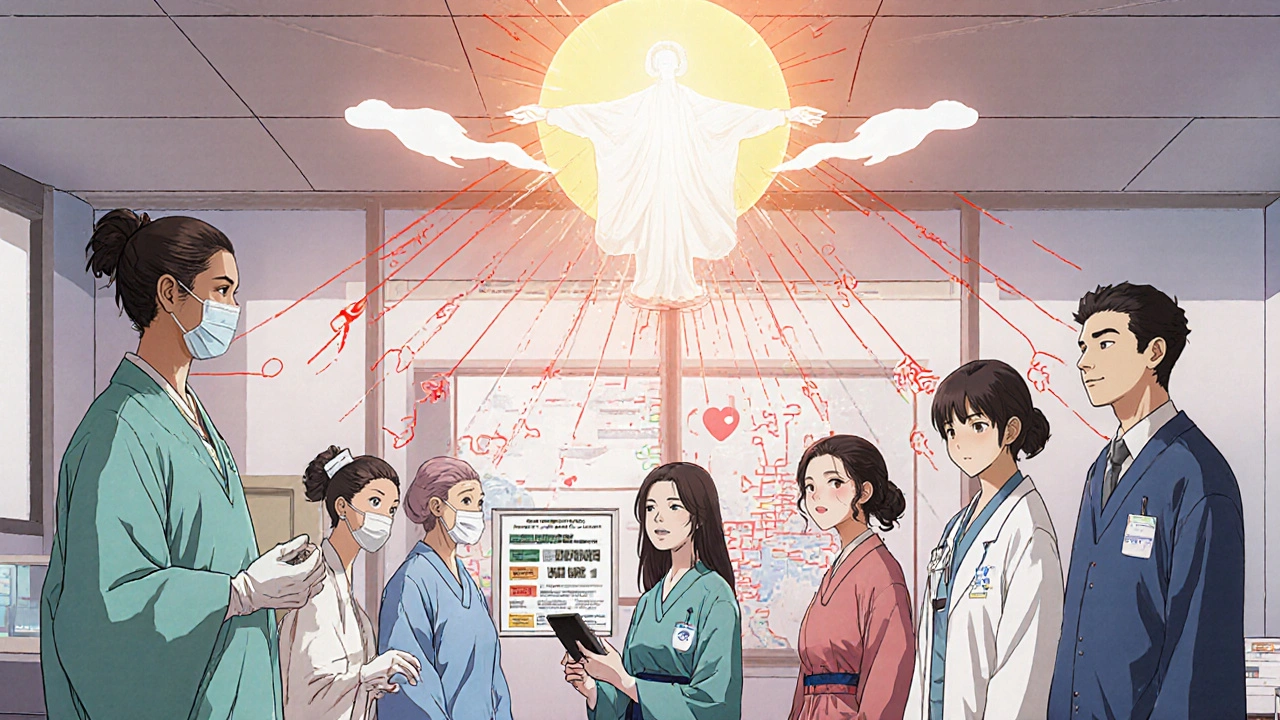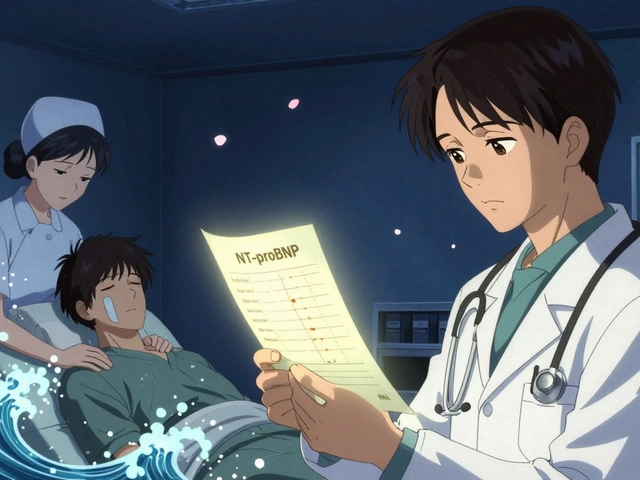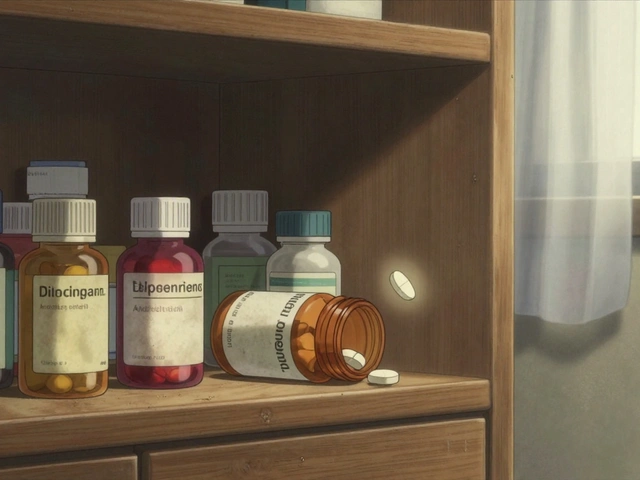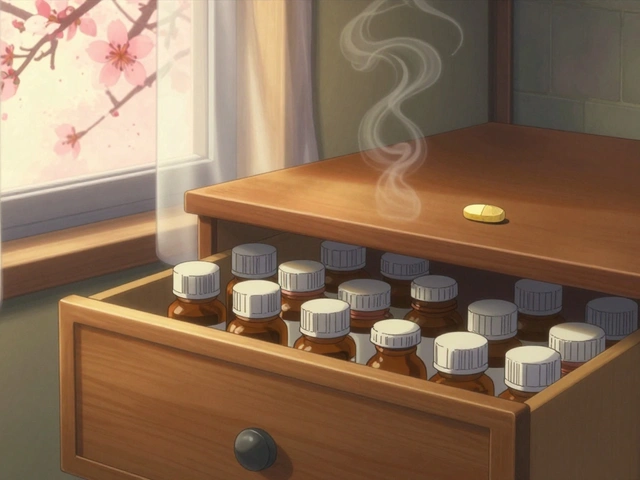Workers on Prescription Drugs Face Hidden Risks on the Job
Imagine a construction worker taking opioids for a back injury, or a nurse using benzodiazepines to manage anxiety. Both are following their doctor’s orders - but neither realizes how much their medication could put them - and others - in danger at work. Prescription drugs like opioids and benzodiazepines don’t just treat pain or anxiety. They slow reaction times, blur vision, and make balance unstable. In high-risk jobs, that’s not just inconvenient - it’s life-threatening.
According to NIOSH data from 2018, 18.7% of U.S. workers with musculoskeletal injuries are prescribed opioids. That’s nearly one in five. For those taking both opioids and benzodiazepines together, the risk of a workplace fall jumps by 84%. In a warehouse, on a ladder, or behind the wheel of a forklift, that’s a recipe for serious injury. Even a few seconds of delayed reaction can mean the difference between avoiding a collision and becoming part of it.
OSHA and CDC studies show workers on these medications are 2.1 times more likely to suffer a workplace injury than those not taking them. And it’s not just physical jobs. Surgeons, pilots, machine operators, and emergency responders are equally at risk. A 2022 report from Medscape documented an anesthesiologist who experienced dizziness and nausea after taking prescribed opioids for a work-related injury - leading to a near-miss during surgery. No one was hurt, but the warning was clear: medication-induced impairment doesn’t care if you’re in a hospital or a factory.
Healthcare Workers Are Exposed to Hazardous Drugs Daily
While some workers are taking medications, others are handling them - and not always safely. In hospitals, pharmacies, and oncology clinics, staff regularly come into contact with antineoplastic drugs, chemotherapy agents, and other hazardous medications. These aren’t just pills. They’re potent chemicals designed to kill fast-growing cells - and they don’t distinguish between cancer cells and human ones.
NIOSH’s 2024 List of Hazardous Drugs includes 370 drugs, broken down into antineoplastic agents (267 drugs), non-antineoplastic hazardous drugs (78), and those with reproductive effects only (25). These drugs can enter the body through inhalation (38% of exposures), skin contact (29% from splashes, 22% from contaminated surfaces), ingestion (7%), or needlesticks (4%). Even tiny amounts - invisible to the eye - can cause harm.
Healthcare workers exposed over time face higher risks of cancer, miscarriage, and birth defects. A CDC meta-analysis of 47 studies found that long-term exposure to hazardous drugs increases the risk of adverse reproductive outcomes by 2.3 times. In one case documented by WorkSafeBC, a chemotherapy nurse developed chronic skin rashes after three years of handling these drugs, despite following all protocols. Surface tests later found detectable contamination in 68% of work areas.
Engineering Controls Can Cut Exposure by Over 90%
There’s good news: most of these exposures are preventable. The most effective solution? Engineering controls - physical changes to the workplace that reduce or eliminate contact with hazardous drugs. Closed-system transfer devices (CSTDs) are one of the most powerful tools. These devices create a sealed pathway when transferring drugs from vials to IV bags, preventing vapors and droplets from escaping.
WorkSafeBC’s 2021 field tests showed CSTDs reduce surface contamination by 94.7%. The American Society of Health-System Pharmacists found that 68% of healthcare workers reported improved safety after their facility installed them. Mayo Clinic’s 2020 program, which combined CSTDs with better training and ventilation, cut hazardous drug exposures by 89% in just two years.
But not every facility has them. Only 78% of large hospitals (200+ beds) have comprehensive hazardous drug programs. Among smaller clinics and outpatient centers with fewer than 50 beds, that number drops to 34%. Many still rely on outdated practices - open vial handling, unsealed waste containers, and inadequate ventilation. A 2022 audit found 31% of facilities had incompatible safety cabinets, and 27% had ventilation systems that couldn’t keep up.

Training and PPE Are Not Enough on Their Own
Many workplaces think: if we just give workers gloves and masks, we’re done. But that’s not how it works. Personal protective equipment (PPE) - gloves, gowns, eye protection - is essential, but it’s the last line of defense. If the drug is leaking, evaporating, or splashing before it even reaches the worker, PPE can’t catch everything.
NIOSH’s validation studies show that even with proper training, 43% of healthcare workers still fail to follow PPE protocols consistently. Why? Time pressure. Lack of confidence. Poorly designed gear. A nurse might skip a gown because it’s hot and cumbersome. A pharmacist might reuse gloves because they’re running behind. These aren’t negligence issues - they’re system failures.
Effective training takes more than a one-hour webinar. USP Chapter 800 requires 16 to 24 hours of initial training, plus 4 to 8 hours annually. Workers need hands-on practice with CSTDs, real-time feedback on donning and doffing, and clear protocols for spill response. A 2021 CDC field study found that after 8 hours of focused PPE training, workers achieved a 92% success rate in proper technique. But without ongoing reinforcement, those skills fade.
Policy Gaps Leave Millions Unprotected
Here’s the uncomfortable truth: not all workers are covered by the same rules. OSHA’s Hazard Communication Standard (29 CFR 1910.1200) applies to about 6.2 million U.S. workplaces. But it doesn’t fully cover healthcare settings where hazardous drugs are handled. That leaves roughly 1.8 million healthcare workers in non-covered facilities - think small clinics, home care agencies, and private practices - without enforceable protections.
USP General Chapter 800, which went into effect in December 2019, sets higher standards for handling hazardous drugs - but it only applies to compounding pharmacies. That covers about 58,000 workers. The rest? They’re left to follow voluntary guidelines.
Even when rules exist, enforcement is weak. Through Q1 2024, OSHA issued 147 citations for hazardous drug violations, totaling $1.2 million in penalties. That sounds like a lot - until you realize how many facilities are out there. For every citation, dozens go unnoticed. Unionized workers, however, fare better. AFL-CIO data from 2023 shows unionized healthcare workers experience 22% fewer medication-related incidents than non-unionized peers, thanks to stronger safety committees and collective bargaining power.

What Workers and Employers Can Do Right Now
So what’s the path forward? It starts with awareness - and action.
For employers:
- Check NIOSH’s 2024 List of Hazardous Drugs. If you handle any of these 370 drugs, you need a plan.
- Install closed-system transfer devices in all areas where hazardous drugs are prepared or administered.
- Conduct quarterly surface contamination tests. If more than 5% of surfaces show detectable levels, you have a problem.
- Train staff using real-world scenarios, not PowerPoint slides. Practice spill responses. Role-play PPE mistakes.
- Review prescription drug use policies. Don’t punish workers for taking legally prescribed meds - but do assess whether those meds impair their ability to perform safety-critical tasks.
For workers:
- If you’re on opioids or benzodiazepines, talk to your doctor about alternatives. Ask: “Could this affect my ability to operate machinery, drive, or respond quickly?”
- Report any symptoms - skin rashes, nausea, dizziness - after handling drugs. Don’t wait until it’s chronic.
- Know your rights. If your workplace lacks proper ventilation or PPE, ask for a safety committee meeting. If you’re ignored, contact your union or local OSHA office.
- Don’t assume “everyone does it this way” is safe. If you see a colleague reusing gloves or skipping a gown, speak up.
What’s Next? AI, New Rules, and a Shift in Culture
The future of work safety around medications is changing. Johns Hopkins Hospital is testing AI-powered monitoring systems that predict high-exposure scenarios with 92% accuracy. These tools analyze airflow, worker movement, and drug handling patterns to flag risks before they happen.
OSHA is expected to propose a new rule in late 2024: a Permissible Exposure Limit of 0.1 ng/cm² for hazardous drug surfaces. That’s an incredibly low threshold - one-billionth of a gram per square centimeter. It’s not just about preventing cancer. It’s about preventing any exposure at all.
And the biggest shift? Medication safety is no longer just an HR or safety issue. It’s part of workplace wellness. A 2024 SHRM survey found 63% of large employers plan to expand medication safety programs in 2024-2025. That means mental health support, pain management alternatives, and drug use assessments will become part of regular health check-ins.
The goal isn’t to eliminate medications. It’s to make sure they don’t cost lives - whether they’re being taken, or being handled.
Can I be fired for taking prescribed medication at work?
Not automatically. Under the Americans with Disabilities Act (ADA), employers must provide reasonable accommodations for workers taking legally prescribed medications - unless the medication impairs your ability to perform essential job functions safely. If you’re on opioids or benzodiazepines and your job involves operating machinery or driving, your employer may need to assess whether you can safely perform your duties. They can’t fire you just for taking medication, but they can require you to demonstrate you’re not a safety risk. Some employers offer alternative duties or modified schedules as accommodations.
Are over-the-counter drugs a workplace safety risk?
Yes, some are. Antihistamines like diphenhydramine (Benadryl) and sleep aids like melatonin in high doses can cause drowsiness and slow reaction times. Even common pain relievers like tramadol can affect coordination. While not classified as hazardous drugs like chemotherapy agents, any medication that causes dizziness, fatigue, or blurred vision can increase injury risk - especially in roles requiring alertness. Always read labels and ask your pharmacist if a medication could affect your job performance.
How do I know if a drug on my job site is hazardous?
Check NIOSH’s 2024 List of Hazardous Drugs in Healthcare Settings. It’s updated annually and includes 370 drugs, categorized by risk. If you’re in a hospital, pharmacy, or oncology unit, your employer should have a copy and a list of which drugs are handled on-site. Look for safety data sheets (SDS) - they’re required by OSHA and must list hazardous components. If you’re unsure, ask your safety officer or pharmacist. Don’t assume a drug is safe just because it’s labeled as “for patients.”
What should I do if I think I’ve been exposed to a hazardous drug?
Wash the exposed area immediately with soap and water. If it’s a splash to the eyes, rinse for at least 15 minutes. Report the exposure to your supervisor and occupational health department - even if you feel fine. Symptoms like skin rashes, nausea, or fatigue may appear hours or days later. Document everything: date, time, drug name, how exposure happened, and symptoms. Your employer is required to maintain exposure records. Early reporting helps track patterns and prevent future incidents.
Is there a safe way to handle chemotherapy drugs at home?
No - and that’s why it’s dangerous. Chemotherapy drugs are designed to be handled only in controlled environments with engineering controls like CSTDs and negative-pressure rooms. If you’re caring for someone at home who’s receiving chemotherapy, follow strict hygiene practices: wear gloves when handling bodily fluids, use dedicated laundry bins, and wash hands thoroughly. Never flush unused drugs down the toilet. Return them to the pharmacy. Never assume household cleaning products can neutralize these chemicals - they can’t. Always consult your oncology nurse for home safety guidelines.








Michael Fessler
November 21, 2025 AT 04:09Just saw this and had to speak up. I work in oncology and we installed CSTDs last year. The difference is night and day. Surface swabs went from 72% positive to under 5% in 3 months. Training matters, but engineering controls? That’s the real MVP. No more guessing if your gloves are enough. The tech actually works. Also, side note - the nurse who got the chronic rash? She’s back on the floor now, no issues. CSTDs saved her career.
daniel lopez
November 22, 2025 AT 01:56Of course the government doesn’t want you to know this - but Big Pharma and OSHA are in bed together. They don’t want you to realize that ALL prescription meds are designed to make you dependent so you keep buying them. And now they’re using ‘workplace safety’ as a cover to force workers into ‘compliance’ programs. Who’s really getting hurt? The workers. The system is rigged. Read the fine print on those ‘hazardous drug’ lists - half of them are just anti-inflammatory meds. This is a distraction tactic. Wake up.
Nosipho Mbambo
November 22, 2025 AT 18:45So… let me get this straight. We’re supposed to believe that a nurse handling chemo for 3 years gets rashes… but the solution is… more equipment? And training? And audits? I mean, sure, fine. But why is this even a thing? Why aren’t we just… I don’t know… using robots? Or better yet - why are we even giving these drugs to people? Isn’t that the real problem? This feels like putting a bandaid on a hemorrhage. And I’m tired of reading 5000 words to get to ‘maybe try gloves.’
Katie Magnus
November 24, 2025 AT 00:54OMG I’m so done with this. Like, I get it. Opioids bad. Chemo bad. But why is everyone acting like this is new? I’ve been a nurse for 12 years. We’ve been dealing with this since the 90s. And now we’re acting like it’s a revelation? This isn’t a crisis - it’s Tuesday. Also, why are we still talking about gloves? I mean… come on. We’re in 2024. We have robots. We have AI. Why are we still making humans touch poison? This is just… sad.
King Over
November 25, 2025 AT 20:57My cousin’s a trucker. Takes melatonin for sleep. Got pulled over for swerving once. They didn’t care it was OTC. Just said he was impaired. Same thing happens with opioids. Doesn’t matter if it’s legal. If it slows you down, you’re a risk. Simple. No drama. Just facts. And yeah, CSTDs work. Saw one in action at a hospital last year. No mess. No fuss. Good tech. Should be standard everywhere.
Johannah Lavin
November 27, 2025 AT 12:21Y’all. I just cried reading this. 😭 I’m a pharmacy tech. I’ve had two near-misses with chemo splashes. One time I didn’t wear the gown because I was late. I didn’t tell anyone. I just washed my arms for 20 minutes. No one asked. No one checked. I’m 29. I want kids. I’m terrified. But I keep showing up because I care. Please. Just… please make this safer. Not for the policy. For us. For the people who show up even when they’re scared. 💛
Ravinder Singh
November 29, 2025 AT 10:15Brothers and sisters, let me tell you something - safety isn’t about gear, it’s about culture. In my hospital in Delhi, we started a ‘Safety Buddy’ system. Two people double-check every chemo prep. No one works alone. We celebrate when someone speaks up. We don’t punish mistakes - we fix the system. And guess what? Our exposure rates dropped 90% in 6 months. No fancy tech. Just people caring enough to look out for each other. The tools help, yes - but the heart? That’s what saves lives. 🙏
Russ Bergeman
December 1, 2025 AT 06:49Wait - so you’re saying workers on opioids are 2.1x more likely to get injured? That’s… statistically significant. But did you control for age? Experience? Job tenure? Also, how many of those workers were actually taking their meds as prescribed? And what about the 18.7% opioid stat - was that from workers’ comp claims or self-reports? And why is the CDC citation so vague? Where’s the dataset? This feels like fearmongering with footnotes. Also - CSTDs cost $12k per unit. Who’s paying? The nurse? The patient? The hospital? Who’s liable when it breaks?
Dana Oralkhan
December 3, 2025 AT 03:53Thank you for writing this. I’ve been a safety officer for 15 years and I’ve watched too many people get ignored because ‘they’re on meds’ - like it’s their fault. But this isn’t about blame. It’s about design. We need policies that say: ‘If you’re on a med that affects your job, we’ll find you a safe role.’ Not ‘you’re fired.’ Not ‘you’re weak.’ Just - ‘we’ve got you.’ And for the nurses handling chemo - you’re not alone. I’ve been there too. You’re not overreacting. You’re not paranoid. You’re right to be scared. And you deserve better. I’m pushing for our clinic to get CSTDs next quarter. Let’s make this happen - together.